 |
|
|
|

Days Three and Four of our Voyage of Discovery were dedicated to collecting the data the students would need to test their theories.
During the data collection phase, each student research team established a work schedule for gathering data, collected and analyzed samples, and recorded their findings.
|
Presentation Project Topics |
|
|
|
|
Scroll down or use the menu to jump directly to a specific project.
|
Research Team 1: Celestial Tracking
|
Students: Amanda, Bibi, Karl & Monet
Senior Crew Advisors: Miles Garfinkel & Jennifer Reilly
Guiding Question: Does the sun really rise in the east and set in the west?
Materials: Quadrant, directional compass, watch.
Procedure: Amanda, Bibi, Karl, and Monet collected their celestial tracking data over the course of two days, while the ship was underway from Duck Island Roads in Long Island Sound to East Haddam on the Connecticut River. Starting first thing each morning, they aimed the quadrant at the sun to determine its elevation in degrees, using the quadrant's shadow to properly align it rather than looking directly into the sun itself. At the same time, they used the directional compass to mark the sun's bearing, or azimuth. As they started in the morning, they initially took readings once every fifteen minutes, but as we approached 1200 hours, they increased the interval between each reading to as little as 5 minutes until the Sun reached its highest point, or zenith, at roughly 1300 hours. Having marked the time of local noon, they slowed their pace once again, but continued to take readings until sundown. For extra practice, the team also tracked the course of other celestial objects by night, including Jupiter and the moon.
Back to Top
|
Research Team 2: Mechanical Advantage
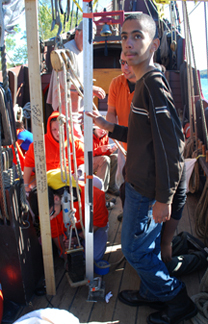 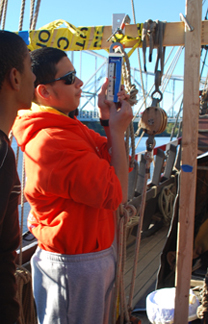 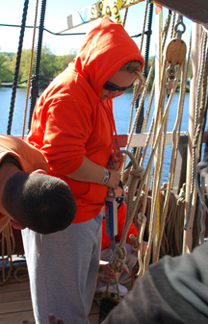 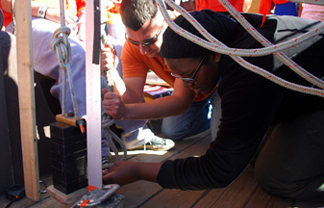
Students: Erica, Kelsey, Roberto & Solange
Senior Crew Advisors: Anthony Roy & Woody Woodworth
Hypothesis: The force needed to lift an object will decrease as more pulleys are added to the machine, and this difference in force will depend on the length of line pulled through the rig.
Materials: Block-and-tackle simple machine, lead weight, spring scale, tape measure, adhesive tape.
Procedure: While the ship was underway from Old Lyme to East Haddam on Day Four, the Mechanical Advantage team constructed a block-and-tackle simple machine on the weather deck with the assistance of their senior crew advisors. The students used their pulley system to lift a 40-pound lead weight exactly two feet off the deck, using the spring scale to measure the force required (effectively, how "heavy" the weight feels) and the tape measure to record the length of line pulled through the machine. They started with a machine consisting of a single pulley and lead, then progressively added leads until they concluded with a five-lead system on the morning of Day Five.
|
Research Team 3: Statistical Analysis
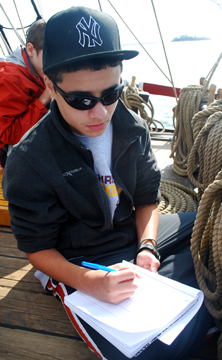
Students: Claudio, Daniel, Teara & Wilberto
Senior Crew Advisors: Stephanie Bisson & Ralf Hensel
Guiding Question: What are the bearings of three fixed objects, as measured with two types of compass, and will there be a difference between trained and untrained results?
Materials: Two hand-held directional compasses ("pistol grip" and "hockey puck"), Half Moon crew members.
Procedure: While the Half Moon remained in place at three separate locations (including an anchorage at Duck Island Roads on Day Three and while docked at the Goodspeed Opera House on Day Four), the Statistical Analysis team instructed everyone in the crew (acting one at a time, from the same location on the ship) to use a directional compass to sight a nearby fixed object, such as a radio tower or a light atop the East Haddam Bridge. (The latter required an intermission once the East Haddam Bridge started to move.) In the first two sighting experiments, they used a pistol-grip compass, switching to a "hockey puck" compass marked with finer increments in the third experiment. At first, they simply handed each crew member the compass and asked them to take a sighting without detailed instruction. After the initial round of sightings, they then had each crew member repeat their sightings, this time following full instruction on how to use each style of compass. The team compiled the crew's sightings and analyzed them to find the mean, median, and mode averages of their results.
|
|
|
|
|
|

